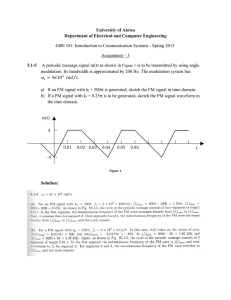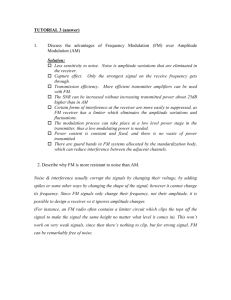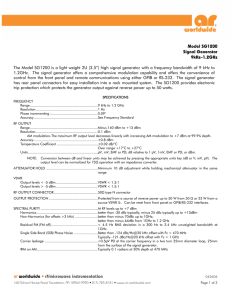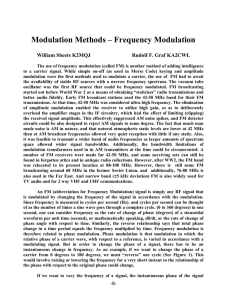Solutions - Sonoma State University
advertisement
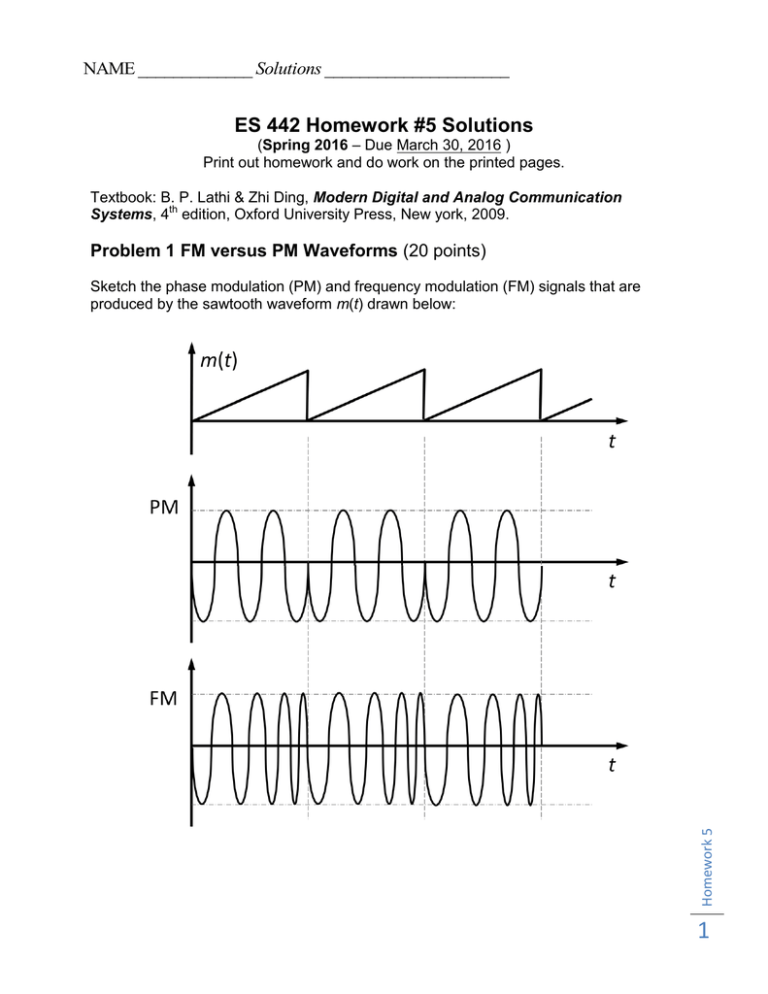
NAME _____________ Solutions _____________________ ES 442 Homework #5 Solutions (Spring 2016 – Due March 30, 2016 ) Print out homework and do work on the printed pages. Textbook: B. P. Lathi & Zhi Ding, Modern Digital and Analog Communication Systems, 4th edition, Oxford University Press, New york, 2009. Problem 1 FM versus PM Waveforms (20 points) Homework 5 Sketch the phase modulation (PM) and frequency modulation (FM) signals that are produced by the sawtooth waveform m(t) drawn below: 1 Problem 2 Bandwidth of a FM Signal (10 points) A 10 MHz carrier signal is frequency modulated by a sinusoidal signal of unity amplitude and with a FM factor kf = 10 Hz/V. Find the approximate bandwidth of the frequency modulated signal if the modulating frequency (single tone) is 10 kHz. Answer: Start with the expression: FM (t ) AC cos (2 fC t ) Modulation Index kf Am cos(2 fmt ) fm kf Am (10 Hz/V)(1 V) 103 4 fm 10 Hz So this is clearly a narrowband FM (NBFM) case. Since it is NBFM we can use the equation that the bandwidth is approximately twice the modulating time frequency fm. NBFM bandwidth BT = 2fm = 20 kHz Problem 3 Bandwidth of a FM Signal (10 points) A 100 MHz carrier signal is frequency modulated by a sinusoidal signal of 75 kHz, such that f = 50 kHz. Find the approximate bandwidth of the frequency modulated signal. Answer: We first check to see if this is narrowband FM or wideband FM. To do this we calculate the modulation index to see if is much less than one radian, or if it is greater. Modulation Index f 50 kHz 0.667 B 75 kHz Therefore, is not much less than one radian, so it is wideband FM (WBFM), and the bandwidth is given by WBFM bandwidth BT = 2B( 1) 2(7.5 104 Hz)(1.667) 250 kHz You are given the equation below for a FM waveform, FM (t ) 100cos (2 105 t ) 35cos(100 t ) From this expression, estimate the bandwidth of the FM signal. Homework 5 Problem 4 (10 points) 2 Answer: Starting with the formula, FM (t ) AC cos (2 fC t ) cos(2 fmt ) we immediately see can equate terms where = 35 and fm = 50 Hz (from 2fm = 100), Now we find the frequency deviation f = fm = 35(50 Hz) = 1750 Hz. WBFM bandwidth BT = 2(f B) 2(f fm ) 2(1750 50) 3600 Hz Problem 5 Multiplexed Signals (20 points) You have two signal sources, one of frequency of (fc + f) and the other of (fc - f), which can be combined into a output y(t) as controlled by a switch. The switch is being toggled at a modulating rate of frequency fm. Sketch the approximate waveform y(t) at the output of the circuit. Note: This is time multiplexing the signals. Homework 5 Answer: The switch alternates between the two frequencies so that the waveform will look something like the sketch below. 3 Problem 6 Frequency Modulation (20 points) A frequency modulator is supplied with a carrier at frequency fc = 5 MHz and an audio tone signal of 1 volt amplitude and frequency fm = 1 kHz. It produces a frequency deviation f of 10 kHz as the output of the frequency modulator. (a) The FM waveform described above is passed through a series of frequency multipliers with a total multiplication factor of 12, that is, fout = 12fc. After passing through the frequency multipliers what is the frequency deviation f at the output? Answer: The multiplier applies to both fc and to f, thus, the increase in the frequency deviation is f after multiplication is f 12 f 12 10 kHz 120 kHz (b) The output of the multiplier in part (a) is next input to a mixer stage with the LO oscillator frequency set at fLO = 55 MHz. Find the sum-frequency output fo of the mixer’s IF port and also find the magnitude of the frequency deviation f. Answer: A mixer produces both sum and difference frequencies at the IF port. The multiplied carrier frequency fc input to the RF port is 60 MHz, hence, the sum frequency is 60 MHz plus 55 MHz = 115 MHz and the difference frequency is 60 MHz minus 55 MHz = 5 MHz. A mixer simply frequency translates a signal so the frequency deviation f remains 120 kHz as found in part (a) above. Therefore, f = 120 kHz. (c) What is the modulation index at the output of the modulator. Answer: The modulation index is simply f 120 kHz 10 fm 12 kHz (d) Next, we change the audio input to the modulator to Vm = 2 volts and the modulation tone frequency fm is reduced to 500 Hz at the modulator’s output. What is the modulation index and the frequency deviation f? Homework 5 4 Answer: The amplitude of the modulating voltage Vm is increased from 1 volt to 2 volts and the modulating tone frequency fm is reduced to 500 Hz (not the typographical error in the problem set which stated 500 kHz). We are asked to find the modulation index and the frequency deviation f f kf Am , and f kf Am fm fm Now we see that f is doubled from it prior value, namely, f = 2kf and 2kf f kf Am , fm fm 500 Hz Homework 5 but 500 Hz is one-half of the prior fm , so 4kf 5
